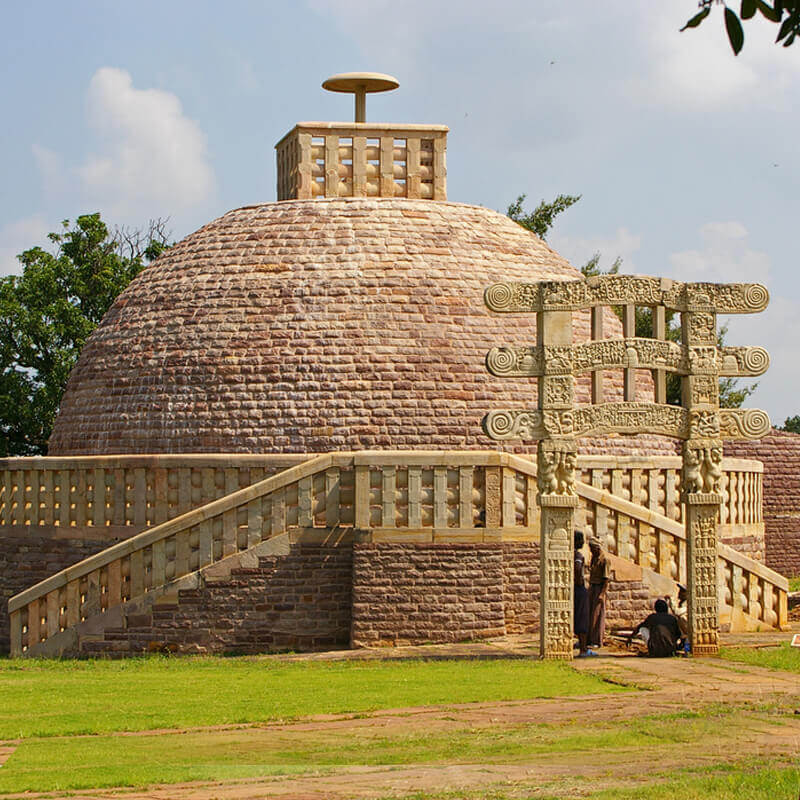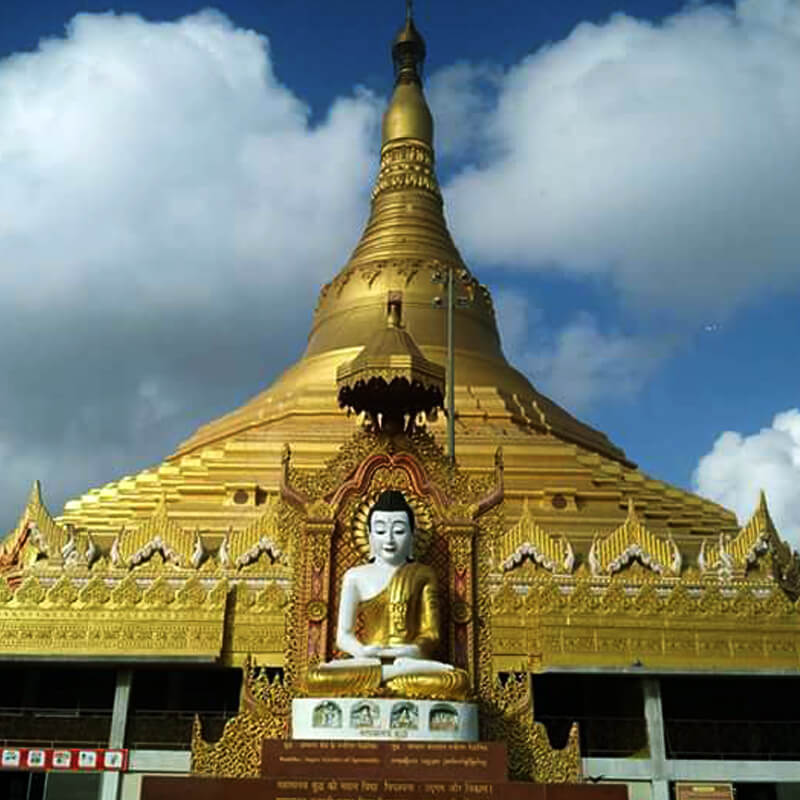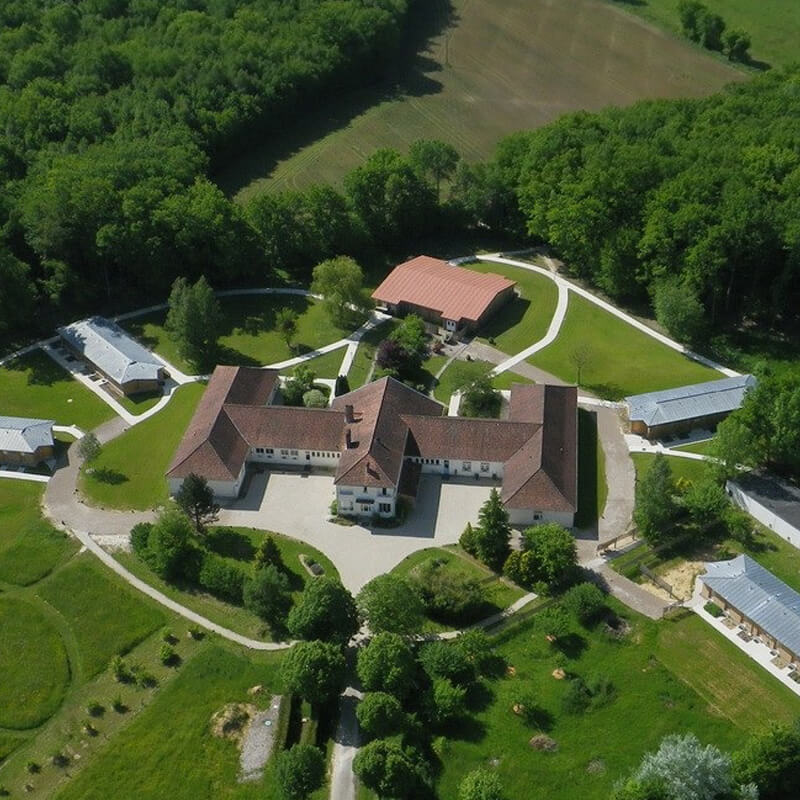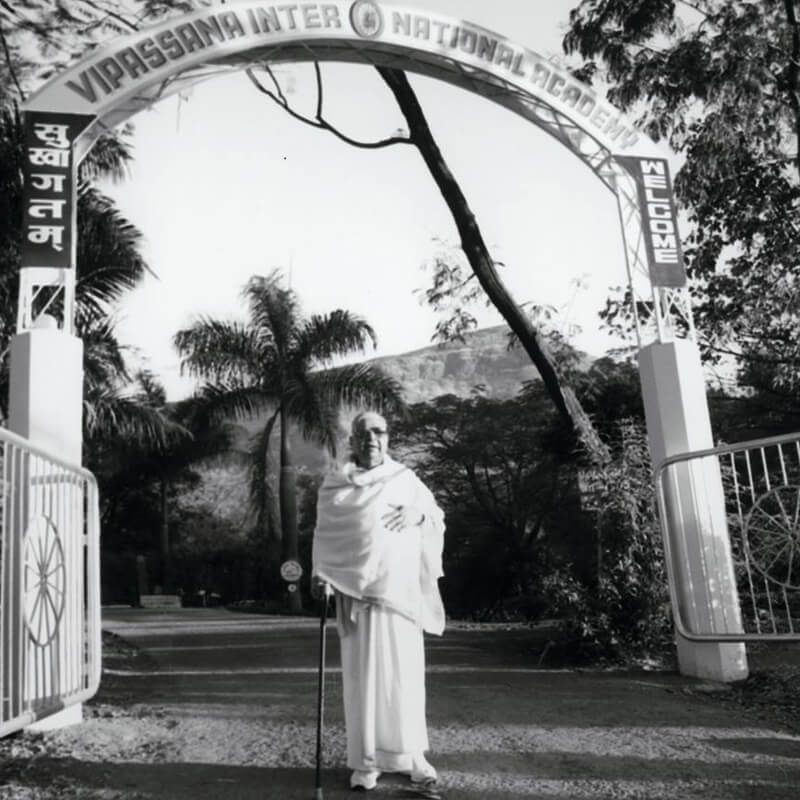24 July 2002: After returning from the meeting with Mr. Jean Chretien, Prime Minister of Canada, Goenkaji was interviewed for the local TV news channel. Later, he met two Vipassana meditators who had flown in from Israel to seek his blessing for their marriage. An expatriate Indian couple came to pay respect to their teacher on the occasion of Guru Purnima (lit. the full moon day of the teacher), so named because the Buddha gave his first discourse, the Dhammacakkappavattana sutta, on this very day in Sarnath.
In the evening, Goenkaji gave a public talk at Carleton University. As the hall started getting full, many Vipassana meditators gave up their seats for people who had not heard Goenkaji before. The Ambassador of Myanmar and the High Commissioner of Sri Lanka were among the audience. After the talk they met him and expressed their appreciation of his dhammadūta work.
July 25: Goenkaji met a bhikkhu in the morning who had travelled from Toronto to meet him, which delayed the departure of the caravan from Ottawa. It was still daylight when the caravan reached Dhamma Suttama in the hilly countryside of Quebec. The local meditators had cleared a small area in the woods on the center property for the caravan, which will be used as a parking lot in the future.
July 26: When Goenkaji came to the West for the first time on his dhammadūta mission, his first stop was Montreal, and the first ten-day Vipassana course in North America was held here. To reach Montreal, Goenkaji had to undertake the almost two-hour journey from Dhamma Suttama, where he had given Vipassana to the one-day course students in the morning. Again, many Vipassana meditators had to give up their places in the hall at the University of Quebec to non-meditators. Most of the people of Quebec are French-speaking, and therefore, Goenkaji's talk was translated into French by an assistant teacher.
Goenkaji was asked why he was touring North America. He replied that Vipassana has given him a lot of peace and happiness, which he wants to share with as many people as possible. This is the quality of Dhamma: ehi passiko (come and see).
In his talks, Goenkaji often says that it is important to become a good human being. He asks, "If one is not a good human being, how can one be a good Christian or a good Muslim or a good Hindu or a good Jew? Vipassana teaches one to be a good human being and thereby one becomes a good Christian, a good Muslim, a good Hindu or a good Jew."
Answering a question, Goenkaji said that Vipassana has spread mostly through word of mouth. When someone benefits from the technique, he or she naturally wants others also to learn Vipassana and benefit from it. To another question, whether one can attain supernatural powers and perform miracles with the practice of Vipassana, Goenkaji replied that the biggest miracle is liberation from misery. Ordinary miracles such as levitation, walking on water, divine eye, divine ear, and reading another person's mind are useless and cannot make one happy. The only true miracle is to eradicate all defilements and to liberate oneself. The same person also asked Goenkaji whether one is able to communicate with guardian angels if one learns Vipassana. The reply was, "Learn to communicate with yourself first; that is more important!"
July 27: Many people wanted to meet Goenkaji. The interviews that started in the morning continued after lunch and just when Goenkaji finished his last interview, he received an overseas phone call. This meant that he did not rest until 4:00 p.m. This day was "Old students' day" at Dhamma Suttama. Goenkaji decided to meditate with the old students in the evening and then gave them a brief talk on Dhamma service. In his talk, he told them that he practised Vipassana under the guidance of Sayagyi U Ba Khin for fourteen years before he was appointed as a teacher. He would often go to the center and do whatever service was necessary. When the time came for him to fulfil the Dhamma wish of his revered Teacher to repay the debt of Myanmar to India by teaching Vipassana, he humbly expressed doubts about his ability. Sayagyi assured him that by the abundant service he had given, including acting as Sayagyi's interpreter for the Hindi speaking meditators, he had earned great paramis, which would give him immense strength. And this is what Goenkaji discovered when he started teaching.
Goenkaji explained that the service given at Vipassana courses and centers greatly helps one's progress on the path. The volition to give Dhamma service is a natural outcome of progress in Dhamma. Without Dhamma service, one's practice remains weak. Dhamma service provides an opportunity to practice, in the conducive atmosphere of a Vipassana center, what one has learned while sitting a Vipassana course. One learns to serve without ego and to deal with students on the courses and with fellow Dhamma workers with love and compassion. Morever, one benefits from the companionship of other meditators and gets an opportunity to clarify doubts about the practice. And, most importantly, Dhamma workers feel so much sympathetic joy on seeing students meditating so seriously to come out of their misery. What can be a greater joy than to see students join a course with so much melancholy on their faces and then to see their faces glowing with joy at the end of the course!
A few years ago, Goenkaji had advised Vipassana meditators to join at least one ten-day course and serve one ten-day course every year. However, if sufficient time cannot be spared, one may serve part-time on a course, help with the maintenance of a center, serve as a host of a group sitting or help in managing one-day courses. There are many ways to serve!
July 28: The one-day course at Dhamma Suttama offered another opportunity for meditators in Quebec to come to the center. Since there is limited accommodation at the center, many drove for hours to get to the center and returned home in the evening. Goenkaji's morning again started with a flurry of interview appointments. Two journalists from a major French daily in Quebec came to interview him. Then Goenkaji went to the tent that served as a meditation hall during his visit to answer questions from students. In the evening, he again gave private interviews before going to the meditation hall tent to meet the trustees and assistant teachers. He emphasized the need to expand the capacity of the center because of the growing demand. He looked around the center and gave guidance on how to expand.
July 29: The Dhamma caravan left Dhamma Suttama and entered the US through a small entry post. It continued its way through the green mountains of Vermont and reached the KOA campsite in Littleton in the evening. This was the last travel-day of the tour.
July 30: Since there was no programme scheduled for the morning, Goenkaji decided to meet some of the volunteers on the caravan. Some of them had never sought any interview with him though they were with the caravan for weeks. He met with them individually and expressed his appreciation of their selfless service. The caravan members took the opportunity to seek his guidance on their practice.
Throughout the tour, Goenkaji had given many talks to businesspeople. Today he again spoke to an audience of invited businesspeople at the John Hancock Center. Goenkaji explained that as one becomes increasingly successful, one acquires more and more material wealth. This can result in more and more attachment to material comforts and sensual pleasures, which leads to fear of losing them. Thus, one lives a life full of anxiety and fear. He then went on to narrate his own life-story and how Vipassana changed his life.
Goenkaji also explained the proper way to give dāna. For any donation to contribute to the peace and harmony of the individual and the community, the volition behind the donation has to be that of compassion and goodwill. One who earns money tends to develop a big ego. And as long as there is ego, there is no peace. This is why a good meditator understands that one is earning not only for the maintenance of oneself and one's dependants but also for others. One gives a bigger or smaller donation according to one's capacity; the amount does not matter. Much more important is to give with a pure mind without expecting anything in return. Then the ego becomes less and less. Dāna becomes impure when one expects something in return. The dāna given with the volition to serve others and to help them come out of their misery helps one progress on the path to real peace. Businesspeople earn more; therefore, it is all the more important for them to utilize part of this earning for the benefit of society.
At the end of the talk, Goenkaji was asked about his spiritual attainments. He replied that one's life should reflect one's attainments. If the so-called spiritual attainments are not translated into upright behaviour in life, they are meaningless. When one meditates to gain a particular experience, one misses the whole purpose behind Vipassana. Attachment to these experiences in meditation generates ego and brings further misery.
July 31: In the morning, Goenkaji again spent time with the caravan crew that had served him during the tour. In the evening, he spoke at the Kresge auditorium at the Massachusetts Institute of Technology (MIT). Goenkaji expressed joy that he was speaking in the great city that has so many world-renowned educational institutions. He explained that Vipassana is a scientific way of understanding oneself. At the end of the talk, he was asked about modern scientific discoveries and the Buddha's insights into material phenomena. Goenkaji replied that the Buddha certainly knew much more than he actually taught. But he taught only that which was necessary for liberation from misery. Goenkaji was also asked why he does not talk much about advanced stages of meditation in his public talks and even during his ten-day courses. Goenkaji replied that theory and practice must go hand in hand. Intellectual knowledge of the so-called higher stages of meditation would not only be useless to someone who has no such experience but also an obstacle to his progress on the path. Goenkaji said that the Dhamma is like the ocean that slopes gradually from the shore and becomes deeper and deeper as one goes further from the shore. The Dhamma becomes increasingly profound as one progresses on the path of Dhamma. After the talk, the caravan drove to Dhamma Dharā and reached there after 1:00 a.m.
August 1: Dhamma Dharā, the Vipassana Meditation Center in Shelburne Falls, is popularly known as VMC among meditators there. It was the first center established in North America and has been serving people for the last 20 years. The meditators and especially all those Dhamma workers who have served there in the last 20 years were overjoyed that Goenkaji was visiting VMC on its twentieth anniversary. When the center was purchased, there were many young and enthusiastic meditators who volunteered their time and skills to build the center. Some of them were present during Goenkaji's current visit.
Goenkaji gave the concluding session of mettā bhāvanā to the thirty-day course students in the morning. Then he met many meditators from the course at noon. In the evening, he meditated in the central meditation cell of the pagoda. It was a great opportunity for many to be able to meditate in the presence of their teacher in one of the oldest meditation pagodas in this tradition. One of the participants was a meditator who had given a lot of service at the VMC and was now dying from cancer. He and his meditator wife had earlier met Goenkaji and told him that they remained joyful and equanimous in the face of impending death. Goenkaji was happy to see a shining example of the courage and equanimity one derives from Dhamma.
August 2: Goenkaji spent most of the day meeting meditators and answering their questions. He also walked around the property with the local teachers. It was a nostalgic walk for Goenkaji and Mataji as they remembered the various stages of development of this first center in the West. At noon, there was a question-and-answer session in the Dhamma hall. In the evening, he met the assistant teachers, trustees, and senior Dhamma workers. He advised the trustees to seek guidance from the teachers and assistant teachers because they have more experience in Dhamma work. He asked the teachers and assistant teachers to be actively involved in all major decisions at the center, especially when a lot of expenditure is involved.
August 3: Meditators came from all over the continent for the opportunity to meditate with their Teacher in a one-day course at VMC. Goenkaji gave Anapana and Vipassana to the students of the one-day course. Later in the evening, he again met meditators. Goenkaji and Mataji were leaving for New York the next day where they would stay in an apartment.
August 4: Goenkaji gave a talk in the Helen Hill Hills Chapel in the Smith College in Northampton in the evening. When Goenkaji came to the U.S. in the year 2000, he had given a talk at the same venue. Goenkaji talked about how he came to Dhamma, his initial doubts about the Buddha's teaching and how he was convinced of its benefits by practice and finally how all his doubts were removed when he read the words of the Buddha. There were many questions after the talk. One question was about how Goenkaji would like to be remembered by future generations. He replied, "Why remember me? Remember the teaching of the Buddha. That is all that matters." After the talk, Goenkaji had dinner, his last meal in the motor home. It was quite late when Goenkaji's motor home started its journey to New York. It reached Manhattan around 3:00 a.m. After all his things were moved to the apartment, Goenkaji's "car house", as he called his motor home returned to Dhamma Dharā.
August 5: Goenkaji gave a public talk in the Sheraton Hotel, Queens in the evening. There is a vibrant expatriate Chinese meditator community in Queens. They had organized Goenkaji's talk in the same venue during Goenkaji's visit in the year 2000. The talk was translated into Mandarin.
August 6: Goenkaji set out in the morning to look at the Museum of Natural History to see how information could be made available to people using modern technology. This was a kind of educational tour for Goenkaji to learn about displays in modern museums. The exhibition gallery in the Global Pagoda will give historical information about the Buddha and his teaching. It will help remove the many misunderstandings that the people of India have about the Buddha and his teaching. Goenkaji is looking for effective ways to do this. He already has an outline of the contents in the gallery but wants to use the most effective ways to present it to people. In the Museum of Natural History, he saw how various dioramas are displayed. He also saw modern interactive ways of educating people. He then decided to visit the Ellis Island Museum of Immigration. It was late in the evening before he returned to his apartment.
August 7: It was the 120th day of the tour. Goenkaji took the opportunity to give a Sangha-dāna at the New York Vihara, which was kindly made available by Ven. Piyatissa Mahathera. Many meditators took the opportunity to visit the Vihara and to serve the virtuous monks even though the Sangha-dāna was arranged on short notice and it was a working day. Ven. Bhikkhu Bodhi Mahathera had kindly consented to be present at the Sangha-dāna. Goenkaji, Mataji and many Vipassana meditators joyfully served the monks. The ambassadors of the permanent commissions of Myanmar and Sri Lanka also joined in this meritorious deed.
Ven. Bodhi Mahathera gave a short speech at the end of paritta chanting. He said that humanity is facing two extremist evils. The first, rampant materialism, is pushing humanity towards extreme hedonism. Corporate greed and materialism are causing an expanding gap between the rich and the poor, thus further destabilizing human society. The second evil, religious fundamentalism, is eroding the values of tolerance and mutual understanding and leading to fanatical outbursts of violence, often taking the lives of many innocent people. The Mahathera said that the message of the Buddha-Dhamma is the need of the hour. He expressed appreciation for the work of Goenkaji. He said that Goenkaji's way of teaching is acceptable to people in modern society, especially those who may not have devotion towards the Buddha. Goenkaji's emphasis on experiential wisdom strikes a chord in the mind of today's scientific and rational generation. This has enabled him to take the Buddha's teaching to people of various religious and ethnic backgrounds all over the world. The Mahathera added, "Most importantly, Goenkaji's successful efforts in the revival of the Buddha's teaching in India are extremely valuable. The world looks upon India as the home of spirituality. For the followers of the Buddha, India has even more significance. Unfortunately, in the last millennium India has suffered in the fields of material progress as well as spirituality. Goenkaji's early success in bringing Vipassana to all sections of the Indian society is a good sign. It is important for India to become strong in Dhamma so as to be the driving force behind the revival of the Buddha-Dhamma around the world."
Goenkaji thanked the Sangha for giving him the opportunity to serve them and expressed gratitude to the Sangha for preserving the pariyatti (words of the Buddha) and paṭipatti (meditation practice). He echoed Ven. Bodhi Mahathera's sentiments on the relevance of the Buddha's teaching in today's world.
Immediately after the Sangha-dāna at the New York Vihara, Goenkaji and Mataji were taken to the airport. They flew out in the early evening for Brussels via London.
(to be continued)






